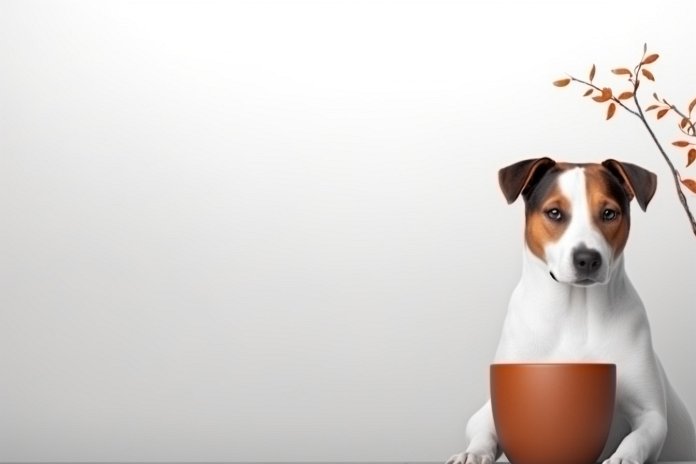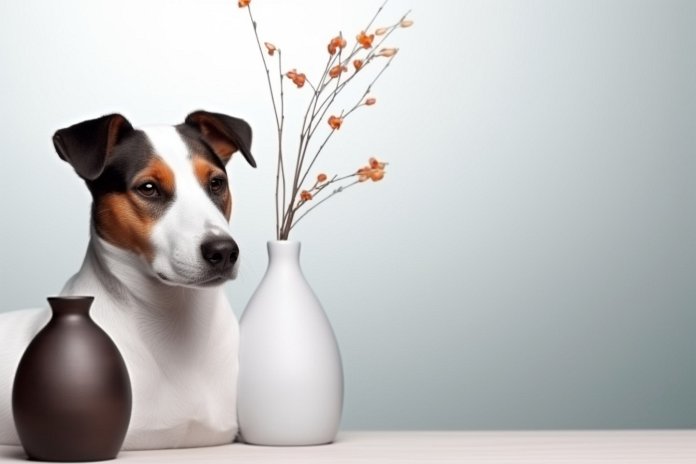
The Aussietare is a mix between a purebred Australian Shepherd and a Bull Terrier. These dogs are known for their high energy levels and make great companions. However, due to their Terrier and Bulldog background, they can be protective and occasionally aggressive. It’s important to provide them with plenty of exercise and avoid leaving them alone for long periods of time. Aussietares are best suited for active households with older children or couples.
They have a lifespan of about 11 to 15 years and can weigh between 50 to 70 pounds. In terms of height, they typically range from 20 to 23 inches. With their medium to short-haired coat, Aussietares come in various colors specific to the Bull Terrier and Australian Shepherd breeds. They may also have Australian Shepherd markings, which can be light or prominent.
Ahead, we look at Aussietare dog breed, its history, personality, pros and cons of owning an Aussietare, characteristics, and must-see facts. We will also examine how to care for this breed and much more. Prepare for a tail-wagging adventure into the world of Aussietares!
| Dog Breed | Aussietare |
| Size | Large |
| Weight | 50-70 lbs (average) |
| Height | 20-23″ (average) |
| Location | United States, United Kingdom |
| Ancestry | Australian Shepherd, Bull Terrier |
| Date of Origin | Unknown |
| Group | Companion |
| Life Expectancy | 11-15 years |
| Price | $600 – $800 |
| Family | Canidae |
| Scientific Name | Canis Lupus Familiaris |
📖 Breed History
The name Aussietare is a combination of its parent breeds’ names: the Australian Shepherd and the Bull Terrier. The Australian Shepherd originated in the western United States and is known for its herding abilities. It has become a popular breed and is now used as a guide dog, therapy dog, and search and rescue worker, in addition to being a beloved family pet. The Bull Terrier, on the other hand, was originally a cross between Bulldogs and various Terriers. It gained popularity in the early 1800s for dog fighting and later became a fashionable companion for high society. The Bull Terrier is most well-known for its white coat. The hybrid of these two breeds, known as the Aussietare, is a relatively new and uncommon hybrid. Its personality and appearance are still evolving, and it is not widely recognized. However, breeders have found that Aussietares tend to have the protective and playful qualities of their parent breeds. It’s important to note that the Aussietare is not recognized by the American Kennel Club (AKC), so if you’re considering getting one, it’s crucial to thoroughly research the breeders.

🐕 Aussietare Appearance
Typically, Aussietares resemble stronger, less fluffy Shepherds with some Terrier traits. They are often a huge breed. The usual weight is between 45 and 65 pounds, and the typical height is between 20 and 23 inches. Their smooth, thick, short to medium-length coat can be straight, wavy, or both. The extensive diversity of patterns and colors found in Aussietares can be attributed to the parent breeds’ vast range of coat variances. Their basic color is usually lighter, with darker patches, accents, or mild Australian Shepherd markings in shades of white, gray, black, brown, and tan. The tail is a short to medium length, with spherical, compact, and strongly cushioned foot. Aussietares have relatively flat foreheads, high-set triangle-shaped ears that frequently flap over, and triangular eyes that are tiny for their big size. They also have an alert and inquisitive face.
| 👀 Eye Color | Varies |
| 🐽 Nose Color | N/A |
| 🐕 Coat Color | Ranges |
⚡ Fun Fact: Aussietare dogs need a lot of social interaction. They desire to always be with someone or around people. This breed hates being left alone.
🐶 Traits & Temperament of Aussietare
We are reviewing and looking at the data related to the temperament, behavior, and traits of this dog breed. Please stay tuned for our update available shortly.
🤝 Are Aussietares Friendly or Aggressive?
Aussietare dogs are typically good with other pets, showing average friendliness towards strangers and cats. They are especially kid-friendly, enjoying the company of children. Aussietare dogs also display average friendliness towards other dogs. This makes them a great choice for elderly individuals, as they are considered one of the top breeds for senior companionship.
This breed is known for being:
- Active
- Loving
- Protective
- Intelligent
- Friendly
- Affectionate
- Tempered
- Sweet
- Trainable
- Good-natured
- Keen
🐩 Aussietare Care & Maintenance
The Aussietare breed requires little upkeep. Its short to medium-length, non-hypoallergenic coat usually doesn’t need to be clipped or styled. Although it is not always essential, occasional brushing should aid the breed’s modest shedding and keep its coat lustrous. Aussietares should ideally be bathed once per month, or more often if necessary. Like owners of other breeds, Aussietare owners should regularly brush their pet’s teeth, trim its toenails, and pay particular care to keeping its eyes and ears clean. If they are clean and in good health, aussietares are not known to slobber or smell.
Aussietare dogs have a moderate amount of shedding, which is a normal part of their hair growth cycle. Brushing their fur regularly can help minimize the amount of hair that is shed. The amount of shedding can vary depending on the dog’s overall health and the breed they belong to. Additionally, these dogs generally require a bath every 6 to 8 weeks.
🍖 Food: We recommend few cups daily, costing you about $0.49 – $1.49 daily, or approximately $30.00 a month.
🐾 Exercise: Aussietare dogs need a lot of exercises. Long walks should be on a daily schedule. If you live an active life, this breed can be a good choice for you.
This dog breed requires to be walked for roughly few miles per week, which equates to about 15 – 35 minutes of physical activity daily. This consistent moderate exercise regimen will help maintain their physical wellness and significantly contribute to their mental stimulation. Consciously setting aside this time for your furry friend can dramatically enhance their life quality, helping them stay energetic, healthy, and mentally alert.
Did you know: Aussietare dogs are high-energy dogs. An active lifestyle makes them happy.
❤️🩹 Aussietare Health & Issues
Some of the major concerns for Aussietare Dog Breed can be:
- Deafness
- Progressive Retinal Atrophy
- Hip Dysplasia
- Von Willebrand’s Disease
- Mitral Valve Disease
While minor concerns include:
- Entropion
- Ectropion
- Cataracts
- Patent Ductus Arteriosus
- Laryngeal Paralysis
🤧 Important: Is Aussietare hypoallergenic? No.
✨ Bonus: Check out cool, creative, and funny names for Aussietare.
⚡ Aussietare Dog Breed Facts
What makes the Aussietare a great choice for families with young children?
The Aussietare is a great choice for families with young children because they are known to be protective and playful. They can form strong bonds with children and are generally patient and tolerant with them. However, it is important to supervise interactions between the dog and children to ensure both parties are safe.
Is the Aussietare breed considered a suitable breed for apartment living?
The Aussietare breed is not considered suitable for apartment living. They are active dogs that require regular exercise and space to roam. Without adequate exercise, they may become restless and develop behavioral issues. A house with a fenced yard would be ideal for this breed.
How much exercise does a Aussietare require compared to other breeds?
Aussietares require a moderate to high amount of exercise compared to other breeds. They are an active combination of Australian Shepherd and Bull Terrier, so they need daily walks, playtime, and mental stimulation to keep them physically and mentally satisfied. Lack of exercise can lead to destructive behavior.
Is the Aussietare breed known for being good with other pets?
The Aussietare breed can be good with other pets if properly socialized from an early age. However, their Terrier and Bulldog lineage may make them more prone to being dominant or territorial with other animals. Introducing them to other pets gradually and under supervision is important to ensure compatibility.
What are other low-maintenance dog breeds similar to the Aussietare?
Some low-maintenance dog breeds similar to the Aussietare include the Labrador Retriever, Boxer, and Border Collie. These breeds are also active and require regular exercise, but they may have slightly lower grooming needs compared to the Aussietare.
What are the common health issues that Aussietares are prone to?
Common health issues that Aussietares are prone to include hip dysplasia, progressive retinal atrophy, deafness, allergies, and skin problems. Regular veterinary check-ups and a good diet can help minimize the risk of these health issues.
Are Aussietares known to be easy to train compared to other breeds?
Aussietares are generally intelligent and eager to please, which makes them relatively easy to train compared to some other breeds. However, their strong will and occasional stubbornness may require consistent and patient training methods. Early socialization and obedience training are crucial for a well-behaved Aussietare.
Are Aussietares more prone to separation anxiety compared to other breeds?
Aussietares can be prone to separation anxiety if left alone for long periods of time. They are social dogs that thrive on human companionship and can become anxious or destructive when left alone for too long. Providing them with mental stimulation, toys, and a routine can help alleviate separation anxiety.
Are there any dog breeds similar to the Aussietare that are suitable for people with allergies?
Some dog breeds similar to the Aussietare that may be suitable for people with allergies include the Poodle, Bichon Frise, and Portuguese Water Dog. These breeds have hypoallergenic coats that produce less dander, making them more tolerable for allergy sufferers.
What sizes of dogs similar to the Aussietare are best for individuals or families with limited space?
For individuals or families with limited space, smaller sizes of dogs similar to the Aussietare, such as Miniature Australian Shepherds or Staffordshire Bull Terriers, may be more suitable. These breeds have similar characteristics but require less space to move around.
Is the Aussietare breed known to be good with children with special needs?
The Aussietare breed can be good with children with special needs, depending on the individual dog’s temperament and training. Their protective and patient nature can make them suitable companions for children with special needs. However, it is important to assess each dog’s temperament and consult with professionals to ensure a safe and compatible match.
How does the grooming and shedding needs of the Aussietare?
The grooming and shedding needs of the Aussietare can vary. They have a medium to short length coat that requires regular brushing to prevent matting and keep their coat healthy. They are moderate shedders, so regular brushing and occasional baths will help keep shedding under control. However, during shedding seasons, they may require more frequent brushing to remove loose hair. Compared to other breeds, their grooming needs are considered moderate.
We use reliable and publicly available data and resources such as AKC and American Canine Registry to ensure that Aussietare dog breed information is accurate and up to date. If you spot an error, please don’t hesitate to bring it to our attention.